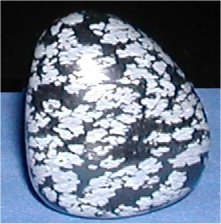
 |
In focus: Obsidian |
| Chemical Composition: 70-75% SiO2 in water plus MgO, Fe3O4 | |
| Group: Volcanic glass | |
| Colour: Black, gray, dark green, red | |
| Streak: white | |
| Hardness: 5-5.5 | |
| Density: 2.6 | |
| Luster: Vitreous | |
| Cleavage: conchoidal | |
|
Pure Obsidian is composed of approximately 70% of Si02 (Silicon dioxide also known as silica from latin silex meaning flint stone) in water. Chemically, Obsidian closely resembles granite and rhyolite but the processes which lead to the formation of Obsidian are different to those which shape granite. Indeed, Obsidian is not a true mineral because it lacks crystal structure. Probably a better description, and that most often used for Obsidian, is a that it is a naturally occurring form of glass. |
While pure Obsidian is dark in appearance, the colour varies depending on the presence of impurities. For example, iron and magnesium gives obsidian a dark green to brown shade. Inclusions of small, white, radially clustered crystals of cristobalite in the black glass produce a blotchy or snowflake pattern. This type of obsidian is commonly referred to as snowflake obsidian. There are very few samples of nearly clear rock.
Obsidian only occurs around volcanoes which have had rhyolitic eruptions. Rhyolitic means eruptions from volcanoes which have highly viscous, silica-rich lava. These can be found in many places around the world including Mexico, North America, Armenia, Turkey, Italy, Greece and Scotland. Obsidian is found in a number of US states, the biggest deposits being within the calderas of Newberry Volcano and Medicine Lake Volcano in the Cascade Range of western North America. The ancient volcanic hills called Glass Buttes in Oregano hold a large variety of gem-quality obsidian, including: mahogany, red, flame, midnight lace, jet black, pumpkin, brown, rainbow, gold sheen, silver sheen, green, lizard skin, snowflake etc, so if you ever thought that Obsidian is just boring black glass, the trip to those parts might be an eye-opener.
The important question is, if obsidian is similar in composition to granite and rhyolite, why does it look so different? The answer lies in the cooling rate and the water content of the original magma. Granite cools very slowly miles below the surface of the earth. This slow cooling over millions of years allows sizable mineral crystals to form within the slowly cooling mass of molten rock. Rhyolite typically cools more rapidly near the earth's surface and contains smaller mineral crystals than granite. When rhyolite magma approaches the earth's surface and the pressure decreases, most of the water in the magma is lost as steam. The resulting silica-rich magma with little remaining water becomes very viscous (thick and pasty) - obsidian magma. This magma is so viscous that sizable mineral crystals cannot grow before the cooling of the magma "freezes" crystal development.
Like all glass and some other types of naturally occurring rocks Obsidian breaks with a characteristic "conchoidal" fracture. Also like other glass, Obsidian is metastable at the earth's surface which means that over time the glass becomes fine-grained mineral crystals. The process can be sped up in the presence of water. This also means that Obsidian is only found in relatively modern areas, and in none older than the Cretaceous age (from 135 million to 63 million years ago).
Although excellent quality obsidian specimens can sometimes be produced by surface lava flows, the best quality of Obsidian forms around volcanic vents just below the ground. As the lava squeezes in between rocks it forms layers of Obsidian that are relatively clear of impurities.
An important property of very viscous lava is that it does not mix well, which means that no obsidian from two different sources is identical. More so, each sample of obsidian can be traced to a specific volcanic eruption.

Obsidian hydration dating is a geochemical method which is often used to determine the age - in either absolute or relative terms - of an ancient artifact made of Obsidian. The technique measures the microscopic amount of water absorbed into freshly broken surfaces. The longer the artifact's surface has been exposed, the thicker the hydration band will be. However, obsidian hydration can only be used on surfaces which were exposed by flintknapping (the process of chipping and shaping flint to give it sharp edges useful for scraping and cutting) and it is not effective on surfaces that are uneven due to gradual weathering caused by natural forces.
To use obsidian hydration for absolute dating it is important to know the conditions that the sample has been exposed to. Otherwise for the technique to be accurate it needs to be compared to samples of a known age (e.g. as a result of radiocarbon dating of associated materials).
| _______________________________ | ||||
| Home | | | Shopping | | | Database |
© Biscuit Software 2004-2015
All rights reserved